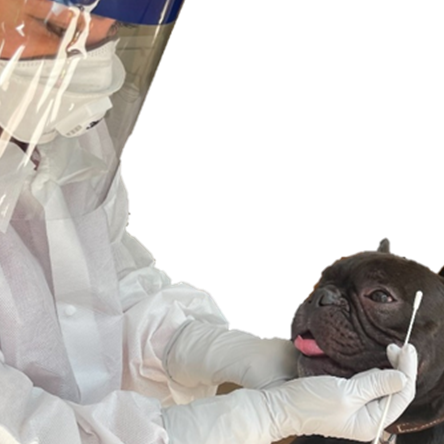Examining Animals With Suspected Mpox
Veterinarians who decide to treat animals with suspected mpox should use infection control precautions to protect themselves, staff, clients, as well as other animal patients in the clinic.
Clinical signs in animals
Illness presentation may vary among animal species. Clinical signs seen in prairie dogs during the 2003 U.S. mpox outbreak included cough and other respiratory signs such as nasal discharge and/or difficulty breathing, fever, red eyes (conjunctivitis), lack of appetite, and rash. Similar signs of illness have also been observed in non-human primates infected with mpox virus in research studies. Some animals may experience a milder form of illness with fewer signs. It is not currently known if animals can be infected without showing signs of illness; however, CDC is conducting a study to learn more.
Mpox transmission between animals and people
Anyone in close personal contact with a person or animal with mpox can become infected and should take steps to protect themselves.
The most common route for transmission of mpox from infected animals to people is direct contact with the infectious rash, scabs, crusts or fluids from sores, saliva, or infected bodily fluids, including respiratory secretions. Urine and feces that contain infectious viral particles may also be a source of infection. It is possible that people with mpox can spread it to animals through close contact, including petting, cuddling, hugging, kissing, licking, sharing sleeping areas, and sharing food.
Preventing transmission in the veterinary clinical setting
Animals with suspected or known mpox exposure within the past 21 days, should not be allowed to enter through the waiting area of a veterinary clinic or hospital, nor should they be taken to a common treatment room. All treatment and diagnostics should be performed in a private examination room away from people and other animals. Limit the number of staff allowed in the exam room and that come in contact with this animal. After each use, clean and disinfect the examination room and any patient care areas where the animal may have been.
When examining and caring for animals with suspected or known mpox virus infections, veterinarians and staff should use the following precautions:
Personal protective equipment (PPE)
- In accordance with veterinary standard precautions [783 KB, 27 pages], wear a gown and gloves for all contact with the sick animal and contaminated surfaces.
- Use eye protection (e.g., tight-fitting goggles or face shield) if splash or spray of body fluids is likely.
- Use a NIOSH-approved particulate respirator equipped with N95 filters or higher when entering the exam room.
CDC staff collecting samples from pets during the 2022 Multinational Mpox Response.





Investigating outbreak of mpox in Democratic Republic of the Congo formerly Zaire, 1996–1997. Dr. Williams, D.V.M. wearing personal protection equipment (PPE) handling two newly acquired giant pouched rats.
Handling of contaminated material
Follow your local health department guidelines for waste disposal.
General precautions:
- Use a dedicated, lined trash can for all potentially contaminated waste. An exception is animal waste, which, along with disposable rodent/small mammal bedding, can be flushed down the toilet if appropriate for the species and your plumbing system.
- Seal disposable rodent/small mammal bedding and other waste that cannot be flushed down the toilet in puncture-resistant plastic bags and dispose of the bags as recommended by your local health department.
- Do not dispose of waste outdoors or in landfills, as this could expose wild animals and household pests like mice and rats to the mpox virus.
- Clean and disinfect potentially infectious non-disposable items.
- Do not dispose of potential infectious items or materials in clinic trash or in landfills without previous disinfection. See waste disposal recommendations above.
Environmental cleaning
- Perform standard cleaning and disinfection procedures using an EPA-registered hospital-grade disinfectant with an emerging viral pathogen claim.
- Products with Emerging Viral Pathogens claims may be found on EPA’s List Q. Follow the manufacturer’s directions for concentration, contact time, and care and handling.
Laundry
- For guidelines on handling soiled and contaminated linens, see Infection Prevention and Control of Mpox in Healthcare Settings.
Hand hygiene
Practice proper hand hygiene after:
- Contact with the animal, whether it appears sick or not
- Contact with potentially contaminated surfaces, including toys, bedding, and other pet supplies
- Removing PPE